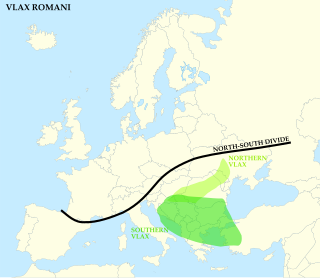Vlax Romani language
| Vlax Romani | |
|---|---|
| romani shib | |
| Native to | Bosnia, Romania, Serbia, Albania, Hungary, Israel; scattered in numerous other states |
Native speakers | 538,480 (2002–2014)[1] |
Indo-European
| |
| Official status | |
Recognised minority language in | |
| Language codes | |
| ISO 639-3 | rmy |
| Glottolog | vlax1238 |
| ELP | Vlax Romani |
 | |
Vlax Romani varieties are spoken mainly in Southeastern Europe by the Romani people.[2] Vlax Romani can also be referred to as an independent language[3] or as one dialect of the Romani language. Vlax Romani is the second most widely spoken dialect subgroup of the Romani language worldwide, after Balkan Romani.
Name
The language's name Vlax Romani was coined by British scholar Bernard Gilliat-Smith in his 1915 study on Bulgarian Romani, in which he first divided Romani dialects into Vlach and non-Vlach.[4][5] The Vlax Roma, a subgroup of the Romani people that speak the Vlax Romani language, originate from the former Roma slaves in the principalities of Moldavia and Wallachia (with the name "Vlax", which comes from "Vlach", coming from the latter), now Romania.[6] The words Romani and Romania are false cognates, the former deriving from Romani rom – ultimately from Sanskrit word ḍoma/डोम, and the latter deriving from Romanian român – ultimately from Latin.
Classification
Vlax Romani is classified in two groups: Vlax I, or Northern Vlax (including Kalderash and Lovari), and Vlax II, or Southern Vlax.[2]
Elšík[7] uses this classification and dialect examples (geographical information from Matras[8]):
| Sub-group | Dialect | Place |
|---|---|---|
| Ukrainian Vlax | - | Ukraine |
| Northern Vlax | Cerhari | Hungary |
| Hungarian Lovari | ||
| Slovakia | ||
| Austrian Lovari | Austria | |
| Polish Lovari | Poland | |
| Norwegian Lovari | Norway | |
| Serbian Kalderaš | Serbia | |
| Italian Kalderaš | Italy | |
| Russian Kalderaš | Russia | |
| Taikon Kalderaš | Sweden[9] | |
| American Vlax | USA | |
| Southern Vlax | Vallachian | Romania |
| Ihtiman | Bulgaria (named after the city) | |
| Gurbet | Serbia and Bosnia Gurbeti | |
| Korça | Albania (named after the city) | |
| Italian Xoraxane | Italy (Xoraxane translates as "Muslims" in the dialect) | |
| Ajia Varvara | Greece (named after a suburb of Athens) |
Writing systems
Vlax Romani is written using the Romani orthography, predominantly using the Latin alphabet with several additional characters. In the area of the former Soviet Union, however, it can also be written in the Cyrillic script.[10][failed verification]
References
- ^ Vlax Romani at Ethnologue (19th ed., 2016)

- ^ a b Norbert Boretzky and Birgit Igla. Kommentierter Dialektatlas des Romani. Wiesbaden: Harrassowitz Verlag 2004. Teil 1: Vergleich der Dialekte.
- ^ "Romani, Vlax".
- ^ Yaron Matras (2002). Romani: A Linguistic Introduction. Cambridge University Press. p. 219. ISBN 9781139433242.
- ^ Bernard Gilliath-Smith as „Petulengro“: Report on the Gypsy Tribes of North-East Bulgaria. In: Journal of the Gypsy Lore Society. New series, volume 9, 1915/1916, p. 1 ff. and 65 ff., especially p. 65: „In making a comprehensive survey of the Gypsy dialects of the whole Balkan Peninsula one would probably begin by distinguishing two great divisions — (1) the non-Vlach Dialects; (2) the Vlach Dialects.“
- ^ Hancock, Ian (1997). "A Glossary of Romani Terms". The American Journal of Comparative Law. 45 (2): 329–344. doi:10.2307/840853. JSTOR 840853.
- ^ Elšík, Viktor (1999). "Dialect variation in Romani personal pronouns" (PDF). p. 2. Retrieved 17 September 2013.
- ^ Matras, Yaron (2002). Romani: A Linguistic Introduction, Cambridge: Cambridge University Press. ISBN 0-521-02330-0
- ^ Hansen, Björn; de Haan, Ferdinand (2009). Modals in the Languages of Europe. Walter de Gruyter: p. 307 ISBN 978-3-11-021920-3.
- ^ "Journey of Besieged Languages" (PDF). ilholocaustmuseum.org. Archived from the original (PDF) on 2018-03-16. Retrieved 2018-03-15.